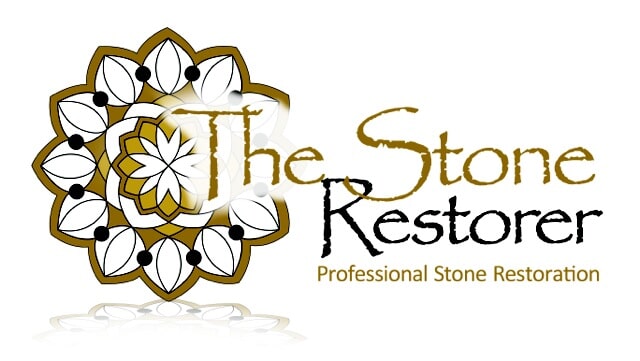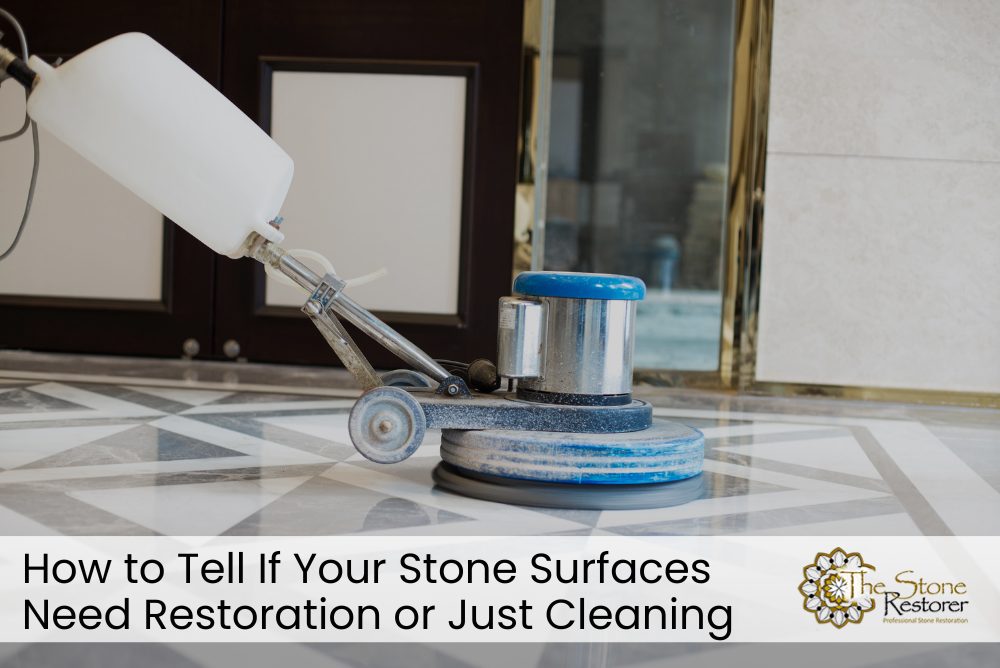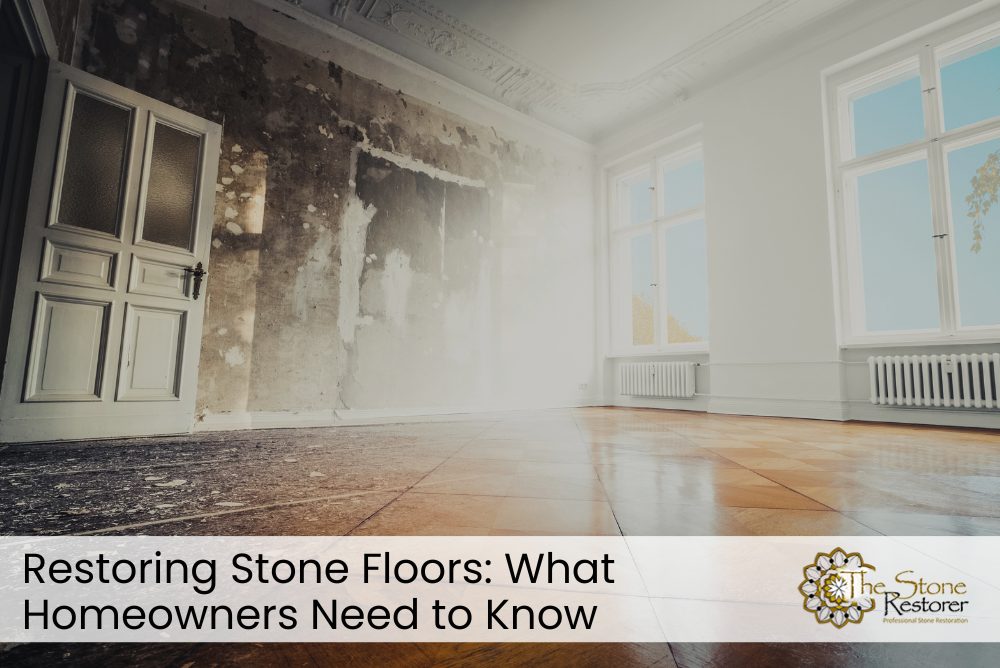Stone surfaces bring class and charm to homes and businesses. Whether it’s marble, granite, limestone or travertine, stone gives off a sense of timeless strength. But over time, these natural materials lose their shine. Scuffs, stains, and chips creep in. That’s when people look into stone restoration. Sadly, a lot of noise out there leads to confusion. Some folks avoid restoration due to common myths. Others spend too much money because of bad advice.
Let’s cut through the clutter. This article dives deep into the biggest stone restoration myths—then busts them with real info, examples and expert insight. If you’ve got stone in your home or worksite, this guide is for you.
Myth 1: “Stone restoration is just polishing”
One of the biggest myths? People think restoration is just a good polish. But that’s far from the truth. While polishing might be part of the job, full stone restoration goes deeper.
Here’s what real stone restoration can include:
- Deep cleaning with non-acidic, pH-neutral products
- Grinding and honing to remove scratches and stains
- Filling chips with resin or colour-matched filler
- Sealing to protect against water and oils
Stone wears down unevenly. One polish won’t fix cracks or deep wear. A true expert knows how to assess the stone’s type, condition and placement. Indoor stone takes different treatment than outdoor stone. Soft stones like limestone need gentler methods than hard granite.
Take this example. A café in Brisbane had marble floors dulled by foot traffic and cleaning chemicals. The owner tried off-the-shelf polish kits. No good. A pro team stepped in and did a full restoration: ground down damaged layers, honed the stone to even it out, then polished and sealed it. It looked like new—and has stayed that way for years.
To see what real work looks like, check out the real process of restoring your stone benchtop. You’ll see it’s a hands-on, skilled job with multiple steps.
Myth 2: “Marble is too delicate to restore”
Many people think marble is too fragile to fix. They assume once it’s scratched or etched, it’s done for. But that’s wrong. Marble is soft, yes—but that’s also what makes it restorable. It can be ground down and reshaped easier than harder stones.
The problem? People confuse “delicate” with “unfixable.” In truth, marble restoration is a careful process that needs the right tools and experience.
A common case is the kitchen benchtop. Hot pans, spills, even lemon juice can mark marble. But with proper grinding, honing and sealing, those stains and etches can be erased. The surface can be brought back, even improved.
And here’s a practical bonus: restored marble holds polish better than new marble. Why? Because restoration densifies the surface over time.
Want a closer look at this idea? Check out common misconceptions about marble restoration vs marble replacement and see why you don’t need to rip out your marble.
Myth 3: “Restoration costs more than replacement”
Here’s a belief that stops people cold: “Restoration must cost a fortune. Might as well replace it.” But let’s break it down.
Replacing stone means:
- Tearing out old material
- Hauling and disposing of debris
- Buying new slabs
- Cutting, finishing and installing
That’s a lot of labour, time and material.
Restoration? It works with what you’ve got. You pay for skilled labour, sure. But you skip demo, disposal and material fees. It’s faster and far less wasteful.
Let’s say you’ve got a chipped granite benchtop. Replacement could cost $3,000 to $5,000, easy. Restoration? You might pay $500 to $1,500, depending on the damage and location.
Take a look at the average cost of stone restoration in Brisbane for real price ranges. It shows how much homeowners and businesses save by choosing restoration.
Myth 4: “You can DIY stone restoration with store kits”
DIY kits promise miracles. But stone doesn’t play nice with shortcuts.
Store kits often contain:
- Harsh chemicals that damage soft stone
- Low-quality polishing pads
- One-size-fits-all instructions
That’s risky. Every stone surface is different. DIY can make things worse. Some cleaners cause etching. Others strip sealants. The result? You call in a pro anyway—plus you’ve added more damage.
We spoke with a Melbourne couple who used a supermarket polish on their travertine floor. It left a milky film and streaks. The stone started cracking. A professional had to grind away the top layer before fixing it.
DIY might sound cheap, but it often costs more in the end. Stone restoration needs the right tools and years of hands-on training. Leave it to the experts.
Myth 5: “Once sealed, stone is damage-proof”
Sealants are vital, but they’re not magic. They slow down staining and water absorption. They don’t block damage forever.
Most sealants wear off within 2 to 5 years. In high-traffic or wet areas, they fade faster. Oil, acid and strong cleaners still cut through them.
That’s why routine care matters. Wipe spills fast. Use mats in kitchens and bathrooms. Stick to pH-neutral cleaners. And yes—re-seal as needed.
A good stone restorer will tell you what kind of sealant was used, how long it lasts, and when to reapply. Don’t assume one seal is a lifetime pass.
Myth 6: “Old stone isn’t worth saving”
This one’s more of a mindset. Some folks think aged stone belongs in the bin. But older stone often has more value than new slabs.
Why?
- Older marble and granite came from now-closed quarries
- Their grain, colour and texture are rare
- With proper care, these stones age beautifully
One Sydney couple had terrazzo tiles from the 1950s. They were dull and chipped. A full restore brought out patterns hidden for decades. The end result? A floor with charm, story and value.
Old stone tells a tale. With skilled work, it can shine brighter than new installs.
Myth 7: “Restored stone won’t last long”
This myth is built on fear. People worry the shine won’t stick. But done right, restored stone can last just as long as the original finish—sometimes longer.
Here’s why:
- Restorers remove damage from the inside out
- They re-hone the surface to reduce future wear
- They use high-quality sealants for longer protection
What matters most is upkeep. Clean it the right way. Re-seal when needed. Avoid heavy impact or harsh chemicals. Restored stone needs the same care as new stone—no more, no less.
With the right habits, your stone will hold up for years. And if it starts to fade? You can refresh it again without a full replacement.
Myth 8: “All stone types are restored the same way”
This one can cost people big time. Every type of stone behaves differently. You can’t treat granite like marble. Or limestone like terrazzo.
Let’s break it down:
- Granite: dense and hard, needs strong pads and diamond abrasives
- Marble: soft and porous, needs gentler honing
- Limestone: chalky texture, reacts badly to acid
- Travertine: full of natural holes, needs filling before polishing
Experts adjust tools, techniques and products based on the stone. If they don’t, you get swirl marks, burn spots or dull patches.
One restorer shared how a hotel used marble cleaner on granite tiles. It etched the surface and created white streaks. Fixing it took hours of grinding and re-sealing.
Moral of the story? Always match the method to the material.
Frequently Asked Questions
1) How do I know if my stone needs restoration or just cleaning?
If your stone has light dirt or water spots, cleaning might be enough. But if it’s dull, scratched, etched or stained, restoration is the better choice. Professionals can run tests to check the depth of damage. A clean will brighten stone. A restore will fix and protect it.
2) How often should I restore my stone surfaces?
It depends on use and location. Kitchen benchtops may need touch-ups every 2–3 years. Bathroom stone often needs re-sealing more often due to moisture. High-traffic floors might need restoring every 5–7 years. A professional can check your stone and give a proper timeline.
3) What’s the biggest risk of waiting too long to restore?
Delaying restoration can lead to:
- Deeper stains that won’t lift
- Cracks that spread and chip
- Sealant breakdown, allowing mould or water damage
- Early intervention is cheaper and safer. Once damage gets deep, full replacement may be the only option.
Are there eco-friendly options in stone restoration?
Yes. Many pros now use low-VOC sealants and biodegradable cleaners. Dry polishing methods reduce water waste. Restoring instead of replacing also cuts down on landfill and quarry mining. Talk to your restorer about green options.
Can I walk on my floors right after they’re restored?
Depends on the treatment. Polishing alone? You might walk on it within hours. Sealants may need a full day to cure. Always follow the restorer’s advice. Jumping in too early can ruin the finish or create slip hazards.
Ready to Refresh Your Stone?
Stone is strong, but myths around it can lead to bad choices. Restoration isn’t a quick polish. It’s skilled, careful work that brings life back to your surfaces. Whether you’ve got aged marble, dull granite or stained travertine, the right team can make it look fresh without ripping it out.
From price myths to DIY traps, we’ve shown that smart restoration saves time, money and materials. Stone is an investment—keep it that way with proper care.
Want to see what’s possible for your home or business? Visit The Stone Restorer and talk to the experts who get it done right the first time.
Give us a call today at 0414 469 301 or ask us for a fast free quote on your tile cleaning or restoration project






